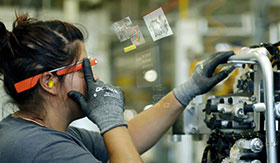

The early morning air was still cold when I arrived together with a colleague at the mine for our underground visit. Our hosts were keen to show us the practical challenges of the drilling and blasting operation, and the many ways in which rock fragments containing ore are removed to the surface for processing.
At the ore face the drilling process was indeed an eye opener, hot, uncomfortable and hazardous in nature. Knowing where to drill to optimise the blast pattern is a skilled operation. When drilling started it was immediately apparent that this was a manual operation, and there was a lot that could go wrong.
Our visit was more than curiosity. Our team was interested to see how augmented reality might be used to improve the drilling procedures, while at the same time enhancing safety. Could an augmented reality display be used to help analyse and superimpose the most efficient layout of the drilling pattern on the rock face for marking the holes? Could a virtual/augmented reality device such as Google glass or Microsoft Hololens be practically used in such a harsh industrial environment? If so, what might a future system look like? At the time, the technology was still immature, but the potential benefits were compelling enough to warrant further investigation.
This underground visit took place over five years ago and since then there have been many important developments in augmented reality technologies. Significant investments have been made by the vendors in hardware and software. New innovations in heads-up displays now make many suitable for use in industrial environments. These displays, together with artificial intelligence and cognitive technologies, promise to be a game changer in the way operators will work in future.
What is augmented reality?
As the name implies, augmented reality is the addition (or augmentation) of the physical world with context aware visual information that can be used to help operators make better decisions, or help guide their actions. The visual information is usually text, a 2D drawing or a 3D model, object or hologram, which is overlaid onto the physical world.
In the control room environment augmented reality can be seen as an evolution of the human machine interface (HMI). Until now, HMI design in a control system has largely been concerned with designing the best ‘mimics’ (graphical displays representing the process). With new augmented reality technologies, we can now move out of the control room and support field operators and maintenance technicians with real-time process information in the field.
Fundamentally, the same design considerations that apply to good control room HMI also apply to augmented reality systems. Remember that the goal is to provide additional information to improve decision making, not replace human judgement or take away responsibility for decisions or actions taken. In practice, this can be a delicate balance that presents a number of problems which we will cover later.
Practical applications
In industrial manufacturing, there are many practical examples of augmented reality applications. The business goal is often to reduce costs, improve productivity and enhance safety.
Complex procedures
In complex assembly or maintenance procedures, augmented reality can help you with a visualisation of the right way to assemble or disassemble a piece of equipment. The display can provide quick access to visualisations of the task at hand based on 3D models that provide a technician with step by step instructions.
Quality assurance
Augmented reality technologies can be used to inspect items of equipment in the field for quality control purposes. The actual item can be compared with a reference image and AI techniques used to indicate a pass/fail when any defects are detected.
Expert support
Human experts can remotely assist field technicians with complex tasks by monitoring the work being done through a camera and providing guidance on complex procedures. This can be particularly useful where expert skills are scarce and not located on site.
Navigational aid
Augmented reality systems can assist in locating people and equipment in the field with context aware navigational information. This can be useful in certain environments where the location of equipment is not static, visibility is poor, or perhaps to help people navigate through complex or inaccessible plant areas.
Safety support
Augmented reality systems can identify elevated safety risk to warn people working in the field. This elevated risk can be determined by a visual analysis combined with data from the DCS/scada, IIoT devices and the maintenance/work permit systems.
Tracking
The location of people can be tracked through IoT devices and this information presented on an augmented reality display to improve coordination and productivity of teams in the field. This could be particularly useful in highly regulated or hazardous plants, as well as for supporting rescue operations.
In the underground mining example earlier, augmented reality can be used to assist with identifying the best drilling pattern as well as guiding the drilling operation itself by analysing the position and angle of the drill head.
The HMI dilemma
As mentioned earlier, an augmented reality system is really an evolution of the HMI. The system as a whole needs to take into account human behaviour and this can introduce several design challenges. There is a real risk of a human placing too much reliance/trust in the system and not paying sufficient attention to the whole environment. The system ideally needs to recommend rather than instruct the operator.
The introduction of augmented reality systems will also have an impact on the skills necessary to design, use and maintain these systems. Operators will in future have vastly improved tools available to enable them to work more efficiently, and they will need to learn how to maximise the advantage of these technologies. New skills will also be needed in the ‘back office’ to develop the algorithms and embed the necessary engineering and operational information in ways that are useful to an operator in the field.
In closure
The growth of augmented reality technologies will result in more and more industrial manufacturing applications becoming mainstream. Areas such as expert support and complex assembly/maintenance are the most likely to see early adoption of systems, particularly where there are many identical repetitive but complex tasks to be performed.
As usual, for most of us a great deal of caution is advisable as with any emerging technology. Start by becoming familiar with exactly what technology is available and immerse yourself in researching what the vendors are working on. Seek out practical case studies in your industry that can guide you away from making expensive mistakes. In deciding on augmented reality investments, always be led by the business priorities and do not get carried away by hype.

Gavin Halse is a chemical process engineer who has been involved in the manufacturing sector since mid-1980. He founded a software business in 1999 which grew to develop specialised applications for mining, energy and process manufacturing in several countries. Gavin is most interested in the effective use of IT in industrial environments and now consults part time to manufacturing and software companies around the effective use of IT to achieve business results.
For more information contact Gavin Halse, Absolute Perspectives, +27 (0)83 274 7180, [email protected], www.absoluteperspectives.com

© Technews Publishing (Pty) Ltd | All Rights Reserved